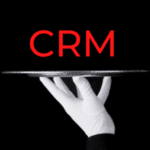The Top 10 Challenges to CRM Success and How to Avoid Them

There are a number of issues and challenges that can occur when implementing a CRM that prevent CRM Success. In fact, research from leading industry experts has suggested that up to 70% of CRM implementations may fail to meet expectations. The good news is that CRM success is possible – if you can identify potential challenges early and are prepared with solutions.
Based on almost 12 years of consulting experience gained while working together with hundreds of Clients on successful CRM implementations, here are some of the biggest potential challenges we typically see – along with some best practices and solutions for success:
1. CRM Success Strategy and Planning
Most firms approach CRM and related technology implementations on an ad hoc basis. But without a strategy and plan, the likelihood of a successful implementation is greatly reduced.
Solution: CRM Success starts with an understanding of your organization’s requirements and goals. This begins with a comprehensive needs assessment. Interviews should be conducted with key stakeholders to discuss current challenges, potential benefits a CRM could provide and how each group or individual define CRM success. Goals from the assessment should become the basis of your planning process. They should be reviewed, agreed upon by stakeholders and assigned to a timeline for completion. Detailed plans are often needed in several key areas including rollout, communication, data quality, training and integration.
2. Lack of Focus
The beauty of CRM is it can do a thousand things, but that doesn’t mean it should. You are more likely to stumble if you try to do too many things or solve too many problems at once, especially right out of the gate.
Solution: Don’t try to boil the ocean. Review your assessment goals and requirements and then take a step back and pick two or three to tackle first. Focus on small, measurable and achievable goals that can demonstrate the value of CRM and grow support for the system over time. Look for the low-hanging fruit that can provide the maximum benefits with minimal effort. Once those have been successfully addressed, move on to the next area. Needs frequently change over time, so you may need to make a few course corrections along the way, but you will also be likely to see that as you solve problems, new groups of users will come knocking at your door wanting to adopt the system for their needs – which is a great problem to have.
3. Buy-In / Adoption
If prospective users don’t see the value of CRM for the organization and, more importantly, the benefits it will provide to them, they will regard system use as a burden and are unlikely to participate. Lack of participation also means the data will suffer, which can undermine the primary reasons for getting a CRM in the first place.
Solution: The question, “What’s in it for me?” must be able to be answered (convincingly) for every user – whether they’re a leader, an assistant or an individual contributor. Taking time early in the implementation to gather needs and requirements for key users and groups will help to answer that question and provide a solid base for realistic goal-setting. Next, the CRM should be configured to meet these needs and requirements, and messaging and training should continually reinforce the value proposition.
4. Communication
If successful CRM requires participation from everyone, it stands to reason that regular communication will be essential. When attempting to institute new processes into the daily work routines of personnel, you must keep those processes – and the goals that those processes will help to achieve – in the minds of everyone whose participation is essential. A common mistake is letting a CRM initiative lose momentum.
Solution: Ongoing communication with CRM users is imperative, before, during and after the system rollout. While email communication is important, it can often be overlooked, so it can be beneficial to supplement using other internal communications channels such as internal newsletters or portal. Communicate system value, answer frequently asked questions, create a knowledge base, give updates as the project progresses and communicate successes to encourage enthusiasm. The message doesn’t always have to have a serious tone. Provide fun statistics about new data coming into the system or have contests to inspire healthy competition as data is entered and training begins. It’s important to remember that communication must be ongoing, taking into consideration that CRM is not a project or initiative, but rather a fundamental change in how you manage your most important assets – your relationships.
5. Leadership Support
All too frequently, we see clients undertake CRM as a marketing or technology initiative without the full support of leadership. At best, these initiatives typically achieve limited success. In most organizations, overall success will never be attained without the full support of management.
Solution: Leadership must have a good understanding of the benefits of CRM. They must have the desire to achieve CRM goals and be willing to champion the implementation. This means that they need to be involved in the process from the beginning. They also should help keep the project top-of-mind for users, get group leaders involved and encourage participation from those less-enthusiastic individuals that every organization has. If it’s not possible to get top leaders engaged at the outset, consider a grass-roots approach starting with leaders at the group or department level.
6. Resources
Successful CRM implementations are not quick, easy or cheap. This is the reason they are also not common. Failure to dedicate adequate resources – including time, money and people – is one of the most frequent missteps. Additionally, expectations regarding the actual costs and time required for a CRM implementation are often unrealistic. When this occurs, the inevitable disappointment that ensues will usually be blamed on the system.
Solution: Be realistic. Make an effort to fully understand the initial and ongoing costs of a CRM deployment from the outset. Take into consideration not only the license or subscription costs but also professional services, ongoing maintenance, training, communication, integration and data quality resources required. Not every organization has the unlimited resources needed to accomplish a laundry list of lofty objectives at the outset. Instead, figure out what can be accomplished with the resources currently at hand that can provide the biggest payback.
7. Data Quality
Data quality is absolutely imperative to CRM success – and poor data quality is one of the most common complaints we hear across the board. Whether it’s incorrect information, duplicative or dated data or lack of information that users need, nothing undermines CRM adoption and success more than degraded data. And if users find issues with the data, they will not use the system.
Solution: Regardless of the CRM system, every organization needs initial and ongoing data stewarding to keep a watchful eye on new records coming in, associate people to companies, monitor changes to records, merge duplicates, research bounced emails and cull contacts that are no longer viable. This is even more important during a rollout, when thousands of new contacts flow into the system, requiring significant additional resources. As the rollout progresses, be sure to leave time before training new groups to focus on cleaning their most important contacts – the ones they are most likely to look for. If the data is bad, they won’t trust the system. It’s also important to create a styles and standards guide to ensure data consistency and increase the speed and efficiency of data cleaning.
8. Admins / Assistants
Never underestimate the importance of assistants to CRM success. Failure to focus on communication and training with this group can often result in poor adoption and data quality concerns. Additionally, if admin participation is considered ‘optional’ or an afterthought or there is no leadership mandate for this group to use the CRM, you will find yourself fighting an uphill battle.
Solution: Involve the admin staff early and often. Solicit their input and feedback. While it can sometimes be challenging to get everyone in the organization to use the system, you can certainly require it of the administrative staff. Admin training should be required, and it should focus on things that are relevant to their work routines and elements of their jobs that can be made easier by CRM. Demonstrate ways the system can help to save time and increase efficiency. Disseminate data standards to show how information should be entered consistently. Create CRM certification standards as a part of their job responsibilities. Ensure that leaders communicate to them the importance of system usage.
9. Training
When CRM systems don’t live up to expectations, failure to focus on training is frequently cited as one of the most pressing problems. After the significant initial investment in a CRM, it would be shortsighted to allow the implementation to languish due to inadequate education. Most important, if users don’t know how to do or find what they need in the system, they will abandon it.
Solution: Training programs must be required and should be customized for types of users. Different individuals perform diverse duties with CRM, so they need individualized training. Have meetings with department or group leaders or conduct a survey to determine individual needs and modify the training to make it relevant for each group. Key users or professionals should be trained desk-side in their offices in brief intervals. For others, classroom training may be more appropriate. Consider the varied learning styles of users and provide information in various formats such as videos and quick reference guides. Add a CRM tips-and-tricks section to your internal newsletter or portal. Create a knowledge base with key documentation. And don’t underestimate one of the keys to CRM success: food! Use pizza parties or lunch-and-learn sessions to get users there. In addition to useful information, provide prizes to motivate them. Additionally, remember that training is not a one-time event, so be sure to focus on new hire and ongoing education.
10. Access to Information
Too often we see instances where there is good data in the CRM but no way to get that data out to make it actionable or to deliver it in a way that users want to access it. Quickly generating aggregated data into useful formats to provide real value to users during the implementation is a goal that doesn’t usually get met – to the detriment of CRM adoption and success.
Solution: Easy access to targeted information will increase adoption. Don’t be hamstrung by out-of-the-box reports. Instead, sit down with stakeholders early in the implementation to identify information they need to succeed and the formats they would like to receive it in. Spending the time to create custom reports that users appreciate will bolster system value and increase adoption. Create saved searches for frequently requested information, provide quick access links to commonly used lists or use dashboards or charts to visualize data.
Of course, this list may not cover every CRM challenge you are facing. We would need a lot more time and space to cover them all. If you would like help with a particular challenge, contact us at 404-249-9914 or Info@CLIENTSFirstConsulting.com. We are always happy to share information, ideas and best practices for CRM Success. Additionally, if you would like to see videos of some of the most common CRM challenges directly from top marketing leaders, visit www.EpicCRMFails.com.
Print a PDF of the article
– For almost 20 years, the team at CLIENTSFirst Consulting has been helping professional services firms and other organizations successfully select and implement CRM and eMarketing systems to maximize value, adoption and return on investment. If you need help with CRM Success, please contact us at 404-249-9914 or Info@ClientsFirstConsulting.com.






